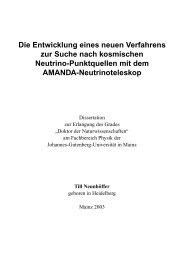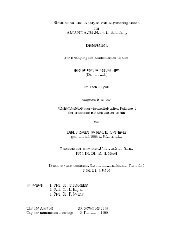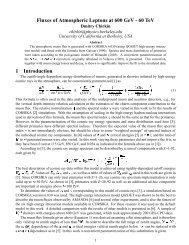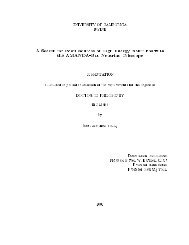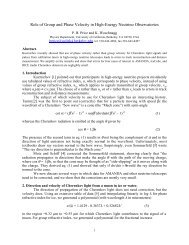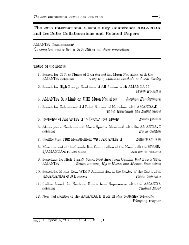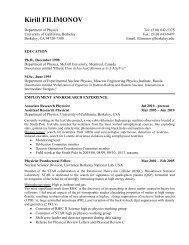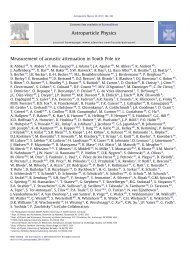Link to Fulltext
Link to Fulltext
Link to Fulltext
Create successful ePaper yourself
Turn your PDF publications into a flip-book with our unique Google optimized e-Paper software.
Figure 17: Distribution of the percentage of after-pulsing over PMs.<br />
in the first place and ¦<br />
has <strong>to</strong> be at least 3 in order <strong>to</strong> avoid the symmetry across the plane<br />
formed by two parallel strings a value of ¦ <br />
could produce. A string multiplicity of ¦<br />
2<br />
would still allow <strong>to</strong> discriminate between up- and down-going muons, but would yield an ambiguous<br />
azimuthal angle due <strong>to</strong> that symmetry. These numbers can be set <strong>to</strong> anything, but for<br />
the AMANDA-B4 detec<strong>to</strong>r operating during 1996, they were ¦ <br />
and ¦ , shortened<br />
¦<br />
<strong>to</strong> 8/1. This trigger was decided just after the deployment in the view that with unknown iceproperties,<br />
a weak condition would be better since it could always be increased off-line. Having<br />
as weak a trigger as possible has proved useful for comparison with Monte-Carlo simulations.<br />
The lowest trigger was thus set, which would produce a data-flow the data-acquisition system<br />
could accomodate. Triggers can also be sent by other experiments (AMANDA-A, SPASE-1,<br />
SPASE-2 or GASP), telling AMANDA-B <strong>to</strong> record whatever data there is.<br />
The differences in cable-lengths for modules at different depths are not compensated before<br />
triggering. Because of the way the trigger condition is set, this has the effect of suppressing<br />
the number of events from down-going particles. Ideally, for such events, the time difference<br />
between two modules hit is increased by the time it takes for electric signal from the lower OM<br />
<strong>to</strong> travel up <strong>to</strong> the upper one. On the opposite, the Cherenkov light from an up-going muon will hit<br />
the lower module first, when hitting the upper module, the first signal will already have travelled<br />
up a bit in the cable. This picture holds in the ideal case of clear ice and straight up- and downgoing<br />
muons. However, simulation studies show that even for AMANDA-B4, some gain can<br />
be made on the signal <strong>to</strong> noise ratio of up-going events versus atmospheric muons, by extending<br />
the delays of deeper modules relative shallower ones [42].<br />
The time difference between signals from the highest and the lowest module for<br />
<br />
an<br />
<br />
up-going<br />
relativistic muon passing ¥ through AMANDA-B4 is ¥ 300 ns and s for a down-going muon.<br />
The length of the time-window used was set <strong>to</strong> 2 s <strong>to</strong> include hits caused by scattered pho<strong>to</strong>ns.<br />
The AMANDA electronics is shown in Fig. 21. The first part is composed of the 86 PMs and<br />
30



